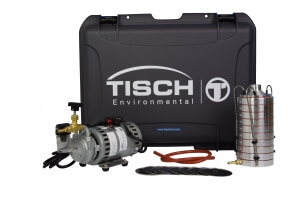The Tisch Environmental ambient non-viable Andersen cascade impactor is a device used to sample both liquid and dry airborne particulates. It is designed with precision-machined aluminum stages that have successively smaller hole diameters as the particulates cascade through the device. The impactor is able to separate particles based on their size, as larger particles will impact on the surface of the impaction plate, while smaller particles will remain in the air stream and cascade through each successively smaller stage until eventually, they are impacted onto an impaction plate.
The TE-20-800 model features a PM10 high capacity pre-impactor that ensures accurate separation of large particles, a high sample flow rate of 28.3 ALPM, and size separation from >10µm to <0.4µm. The impactor also has an optional volumetric flow controlled vacuum system and is made of corrosion-resistant alloy aluminum with silicone seals.
One of the key features of the Tisch Environmental ambient non-viable Andersen cascade impactor is its ability to virtually eliminate particle bounce and re-entrapment, which is crucial for achieving the highest proven collection efficiency, reproducibility, and accuracy. The impactor also incorporates U.S. Federal standards for the “Ideal Cascade Impactor” and meets OSHA, EPA, and ACGIH design requirements for respirable/non-respirable fractions.
The impactor is capable of aerodynamic particle separation in nine size fractions and has 81mm sample substrates for easy handling and weighing with analytical balance. The cut point for the Eight Stage Non-Viable Andersen Impactor at 28.3 LPM is as follows: Pre-separator at 10.0µm and above, Stage 0 at 9.0µm, Stage 1 at 5.8µm, Stage 2 at 4.7µm, Stage 3 at 3.3µm, Stage 4 at 2.1µm, Stage 5 at 1.1µm, Stage 6 at 0.7µm, and Stage 7 at 0.4µm.
Overall, the Tisch Environmental ambient non-viable Andersen cascade impactor is a highly accurate and reproducible device that is ideal for a range of applications that require the measurement and analysis of airborne particulate matter.

